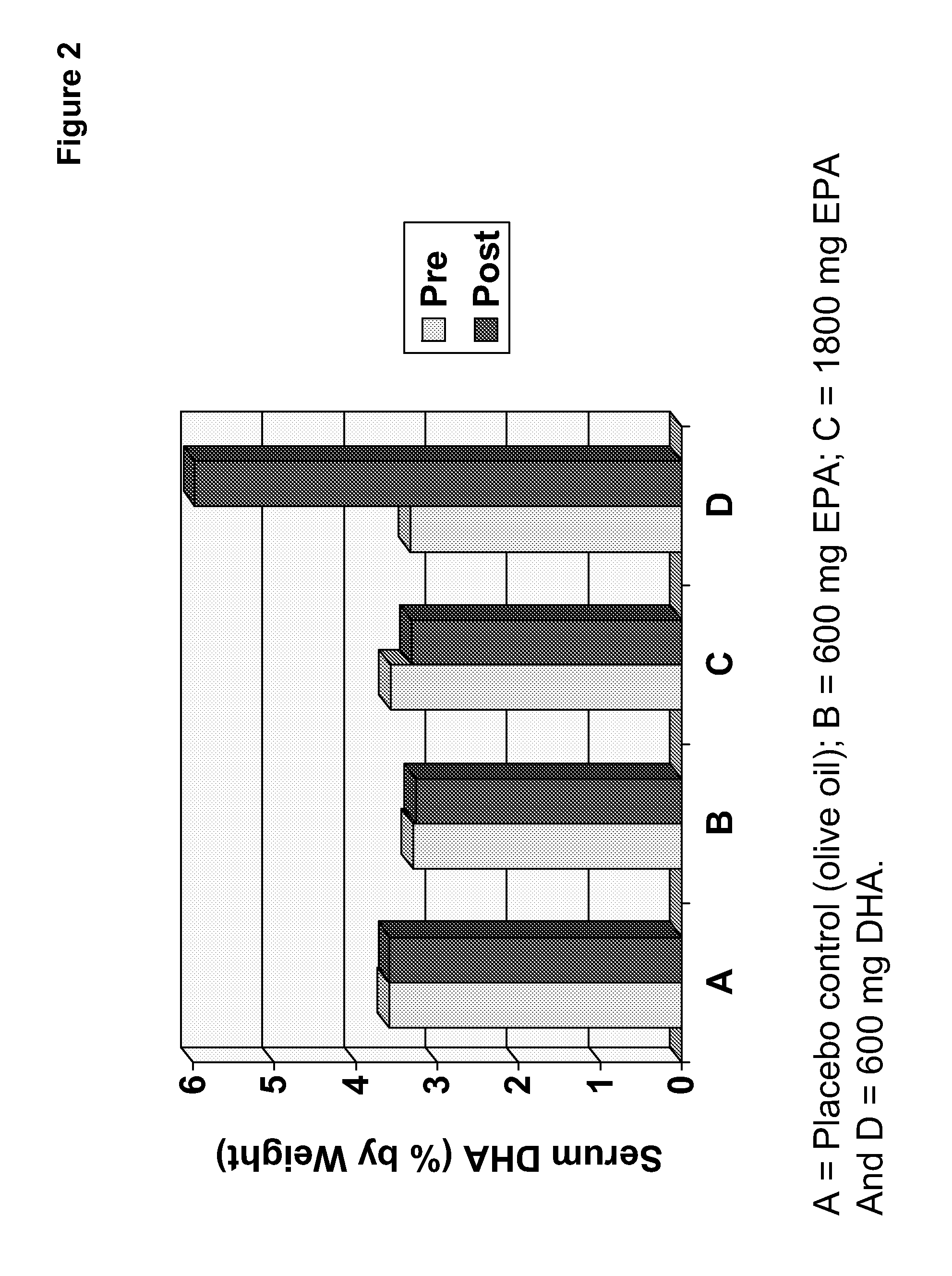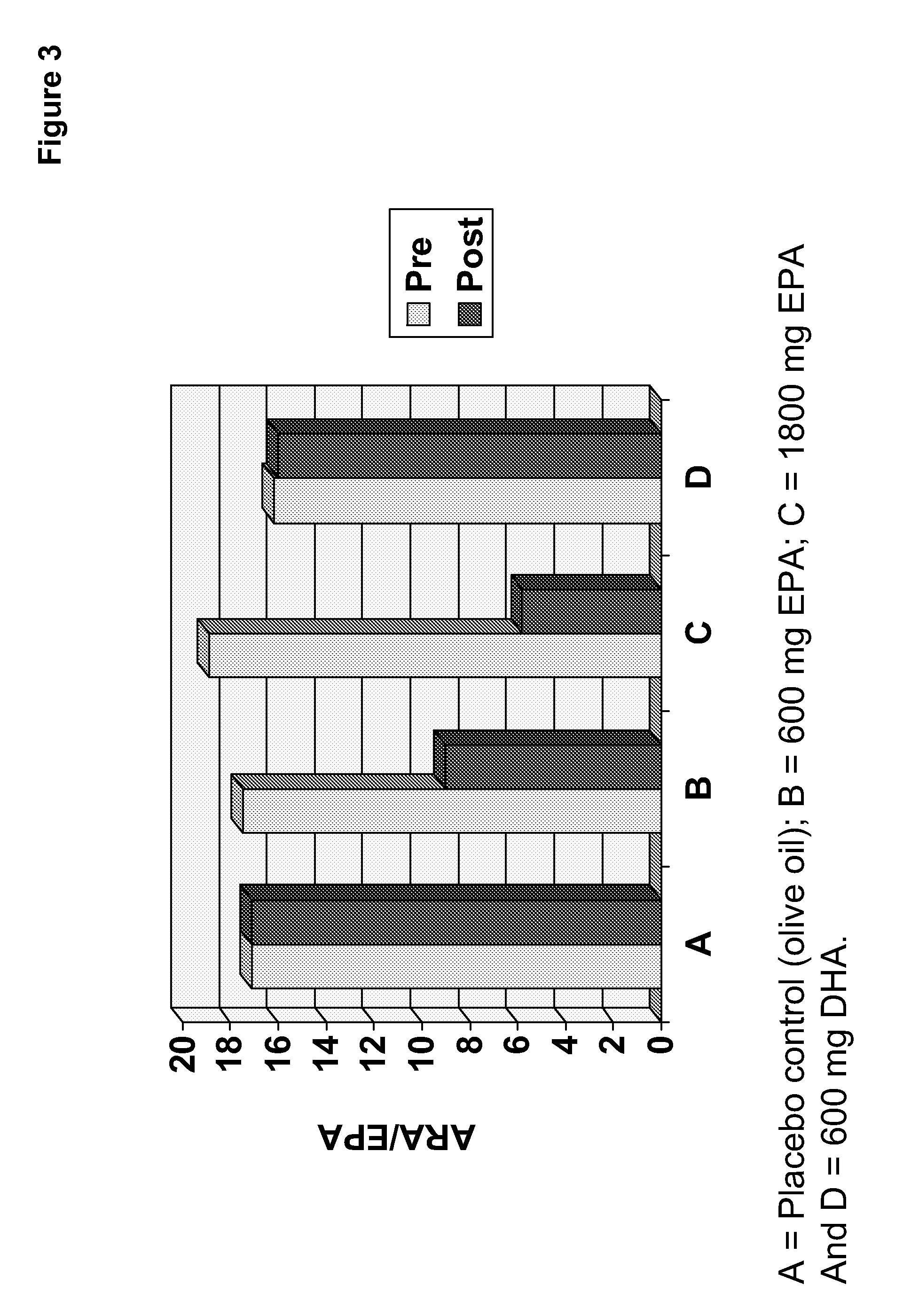Clinical benefits of eicosapentaenoic acid in humans
a technology of eicosapentaenoic acid and human body, applied in the field of biotechnology, can solve the problems that the study did not consider the possible benefits of a relatively pure substance, and achieve the effect of without raising ldl cholesterol levels, and maintaining or lowering lp-pla2 levels
- Summary
- Abstract
- Description
- Claims
- Application Information
AI Technical Summary
Benefits of technology
Problems solved by technology
Method used
Image
Examples
example 1
[0142]Generation of Yarrowia lipolytica Strain Y4305 F1B1 To Produce About 50-52% EPA of Total Fatty Acids [“TFAs”] with 28-32% Total Lipid Content
[0143]The present Example describes the construction of strain Y4305 F1B1, derived from Yarrowia lipolytica ATCC #20362, capable of producing about 50-52% EPA relative to the total lipids with 28-32% total lipid content [“TFAs % DCW”] via expression of a Δ9 elongase / Δ8 desaturase pathway.
[0144]Strain Y4305F1B1 is derived from Yarrowia lipolytica strain Y4305, which has been previously described in the General Methods of U.S. Pat. App. Pub. No. 2008-0254191, published on Apr. 9, 2009, the disclosure of which is hereby incorporated in its entirety.
Description of Parent Strain Y4305 (Producing about 53% EPA of TFAs)
[0145]The final genotype of strain Y4305 with respect to wild type Yarrowia lipolytica ATCC #20362 was SCP2-(YALI0E01298g), YALI0C18711g-, Pex10-, YALI0F24167g-, unknown 1-, unknown 3-, unknown 8-, GPD::FmD12::Pex20, YAT1::FmD12::...
example 2
Fermentation and Downstream Processing to Obtain EPA Containing Microbial Oil from Yarrowia lipolytica Strain Y4305 F1B1
[0152]Inocula were prepared from frozen cultures of Yarrowia lipolytica strain Y4305 F1B1 in a shake flask. After an incubation period, the culture was used to inoculate a seed fermentor. When the seed culture reached an appropriate target cell density, it was then used to inoculate a larger fermentor. The fermentation is a 2-stage fed-batch process. In the first stage, the yeast were cultured under conditions that promote rapid growth to a high cell density; the culture medium comprised glucose, various nitrogen sources, trace metals and vitamins. In the second stage, the yeast were starved for nitrogen and continuously fed glucose to promote lipid and PUFA accumulation. Process variables including temperature (controlled between 30-32° C.), pH (controlled between 5-7), dissolved oxygen concentration and glucose concentration were monitored and controlled per stan...
example 3
EPA Oil Encapsulation and Packaging for Clinical Studies
[0156]In preparation of a clinical study, designed to test the safety and efficacy of the EPA-enriched oil of Example 2 as compared to an olive oil placebo and a comparator oil providing DHA (supra), four types of PUFA-containing capsules were prepared and / or packaged for human consumption.
Oil Encapsulation
[0157]A single lot of oil from Example 2 was utilized to prepare doses of 100 mg and 300 mg EPA suitable for human consumption. Where needed, the EPA-enriched oil of Example 2 was diluted with olive oil. The same lot of olive oil was also used to prepare the control. Food-grade antioxidants designed to minimize oil degradation were added to the olive oil control (and therefore the olive oil used to dilute the EPA-enriched oil). Thus, both the 100 mg and 300 mg EPA oils contained the appropriate amount of anti-oxidant. The composition of the olive oil, 100 mg EPA oil and 300 mg EPA oil were analyzed to determine the complete f...
PUM
| Property | Measurement | Unit |
|---|---|---|
| Mass | aaaaa | aaaaa |
| Mass | aaaaa | aaaaa |
| Mass | aaaaa | aaaaa |
Abstract
Description
Claims
Application Information
 Login to View More
Login to View More - R&D
- Intellectual Property
- Life Sciences
- Materials
- Tech Scout
- Unparalleled Data Quality
- Higher Quality Content
- 60% Fewer Hallucinations
Browse by: Latest US Patents, China's latest patents, Technical Efficacy Thesaurus, Application Domain, Technology Topic, Popular Technical Reports.
© 2025 PatSnap. All rights reserved.Legal|Privacy policy|Modern Slavery Act Transparency Statement|Sitemap|About US| Contact US: help@patsnap.com



